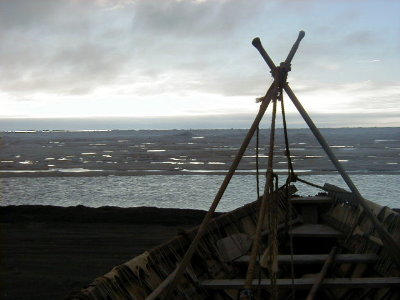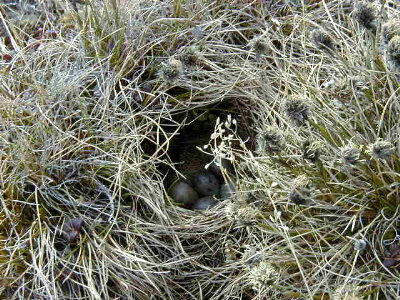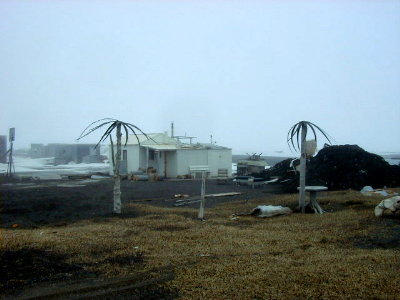
|
|
23 June, 1999
Wednesday, June 23rd
Contents: views of the tundra...
Guest Speaker: Angela Matz, wildlife toxicologist
Pictures:
Hi everyone! I have had a few requests for just everyday kind of pictures of
what I see up here. Thank you so much for the input - I am glad to share this
experience in anyway I can! :-D Below, I have put some of the pictures I have
taken that haven't really fit in with things I have talked about so much. I
am not sure why my captions are coming out all crazy, but please ignore all
the = marks. Please also ignore all of the grammar mistakes and typos - I am
shocked at all my mistakes when I go back and look at what I wrote a few days
later. I will correct them, eventually. But I am more concerned with keeping
you updated! Along the same lines, I think some of Steve Brooks input as
yesterdays guest speaker was accidentally deleted when it was saved onto a
disk. He is out of town until the end of the month, so I will try and catch
him as he comes back and I leave!
Each day we are looking for more eiders. In a day or two, we will have
covered all of the land that is most critical to survey - and some of the
volunteers from the USFWS (United States Fisheries and Wildlife Service) will
undoubtedly return home to their normal jobs and normal lives. :-C. The
people that remain will begin nest searching, since the first eider nest of
the season has been found! (Not the first made, I am sure, but the first we
have seen!) In this phase of the study, there will be less walking transects
(lines) across the tundra, and more searching in the areas that we have found
to be "hot spots" for eiders. Nests will be marked and monitored. The eggs
in the snowy owl nests around here are starting to hatch, so hopefully soon I
can send you a good picture of baby snowy owls! Today, I saw the neatest
thing. A tiny bird called a Lapland Larkspur had a nest I found out on the
tundra, and inside the nest was a bird that must have JUST been born. Its
head was still translucent (see-through), and it had just a couple of tiny
little feathers sticking out here and there. It was about the size of the
last joint on my pinky finger. I tried to take a picture, but did not have
the digital camera with me, so I can not put it on the computer; it is on my
regular camera. It is pretty easy to find nests on the tundra, since there
are no trees. Birds give themselves away by doing what is called a "rodent
run"; they hunch over and run away with their feathers fluffed out, trying to
lure you away from the nest. Or they pretend to have a broken wing. These
behaviors might work on a fox or other predator looking for a meal, but they
are an indication to humans that there is a nest nearby! So when I flushed
the larkspur (made it leave it's nest), it did a rodent run and I was able to
find the nest, which was small!
Tonight, we went out for pizza, and 9 of us fit into the cab of the
truck (there IS a back seat) since no one wanted to ride in the back, where it
would be windy. We are all getting enough of being cold during the day! A
cheeseburger at the place where we went was $9.50. I forgot to look at the
pizza prices, but it was expensive. I don't think I mentioned how great
everyone here is to work with. Everyone has been INCREDIBLY nice and
accomidating. It will be hard to leave for that reason - it's hard to find so
many great people, who remain great even when you have spent time with them in
harsh conditions and close quarters!
Speaking of which - Angela Matz, the guest speaker for today, was kind
enough to come over to the Wildlife Management office of the North Slope
Borough, even though she was really sleepy and ready for bed.... Thank you to
her! Michele Hauschulz (Teacher Experiencing the Arctic)
Guest speaker: Angela Matz
Hi everyone - I'm a wildlife toxicologist (someone who studies the effects of
pollution on wildlife) working for the U.S. Fish and Wildlife Service. I work
out of Fairbanks, Alaska, and I'm up here in Barrow for the week working on
the Steller's eider project. It's good to talk to you! I moved to Alaska in
January (a cold time of year!)from Maine, where I was working on bald eagles.
I also was doing work in Massachusetts and Delaware, looking at the effects of
pesticides like DDT, industrial products like PCBs, and heavy metals on herons
and other birds. All of these pollutants get into our environment, and then
into the wildlife, in different ways - and not all pollution has a negative
effect on wildlife. However, when it does, we want to understand it and try
to stop it. I got into this field by reading the book "Silent Spring" by
Rachel Carson - it's a good book to read to understand how some of our actions
can affect the world around us.
Up here in Barrow, we think the Steller's eiders may get lead poisoning. In
ducks and other waterfowl, this usually happens from eating lead shot left in
the bottom of ponds in areas where waterfowl are hunted - such as up here on
the tundra. Ducks need grit in their gizzards to help digest their food, and
lead shot looks a lot like grit, so they pick it up. However, it dissolves in
the bird's digestive tract and poisons them, the same as if you were to eat
leaded paint. So, we'll look at lead levels in live birds by taking a blood
sample,and look at levels in dead birds by analyzing their tissues for lead.
There are a number of other pollutants or contaminants that may affect these
eiders, and we can look in their eggs for those. Eggs may not hatch if
contaminant levels get too high, and if eggs don't hatch then populations can
drop, and the Steller's eider populations are already low.
Today was my first day out on the tundra, and I had a great time. There are
just a ton of birds out there - every time I turned around a brand new bird
was popping up. We found the first nest of the season today - the Steller's
eider female was so camoflouged that I almost walked right over her before I
saw her! She stuck tight to her nest, though, and I saw her in time to back
up and walk way around. I'll go back home to Fairbanks next week with that
picture in my head, and hopefully some idea of how healthy the Steller's
eiders are. Good to talk with you - Angela
If you have questions for Angela, be sure to e-mail me before Monday, when she
heads back to Fairbanks! Michele
____________________________________________________________________
Get your own FREE, personal Netscape WebMail account today at http://webmail.netscape.com.

Angela Matz, wildlife toxicologist, showing us how to check for contamina= nts inside an egg ____________________________________________________________________ Get your own FREE, personal Netscape WebMail account today at http://webm= ail.netscape.com.

Scenery shot! The frozen ocean and an umiaq - a skin boat (from bearded s= eal skins) used for whaling. ____________________________________________________________________ Get your own FREE, personal Netscape WebMail account today at http://webm= ail.netscape.com.

The sign at Point Barrow: "Danger! Polar Bears!" ____________________________________________________________________ Get your own FREE, personal Netscape WebMail account today at http://webm= ail.netscape.com.

A lemming nest. Lemmings are little brown mammals which look like hamste= rs. = They have little runways in the tundra and lots of holes to hide in. Tha= t is a good thing, because many things (birds, foxes) like to eat them! ____________________________________________________________________ Get your own FREE, personal Netscape WebMail account today at http://webm= ail.netscape.com.

One of the many birdnests on the tundra. Because there are no trees on t= he tundra, nests are made on the ground, and are everywhere! ____________________________________________________________________ Get your own FREE, personal Netscape WebMail account today at http://webm= ail.netscape.com.

Just like Hawaii! (Not quite) These palm trees are made of driftwood tru= nks and baleen palm fronds. Baleen is found in bowhead whale mouths , and is= used to help filter and catch the tiny plankton that is their food! Humpback whales, which migrate to Hawaii in winter, are also baleen whales. ____________________________________________________________________ Get your own FREE, personal Netscape WebMail account today at http://webm= ail.netscape.com.
Contact the TEA in the field at
.
If you cannot connect through your browser, copy the
TEA's e-mail address in the "To:" line of
your favorite e-mail package.
|
